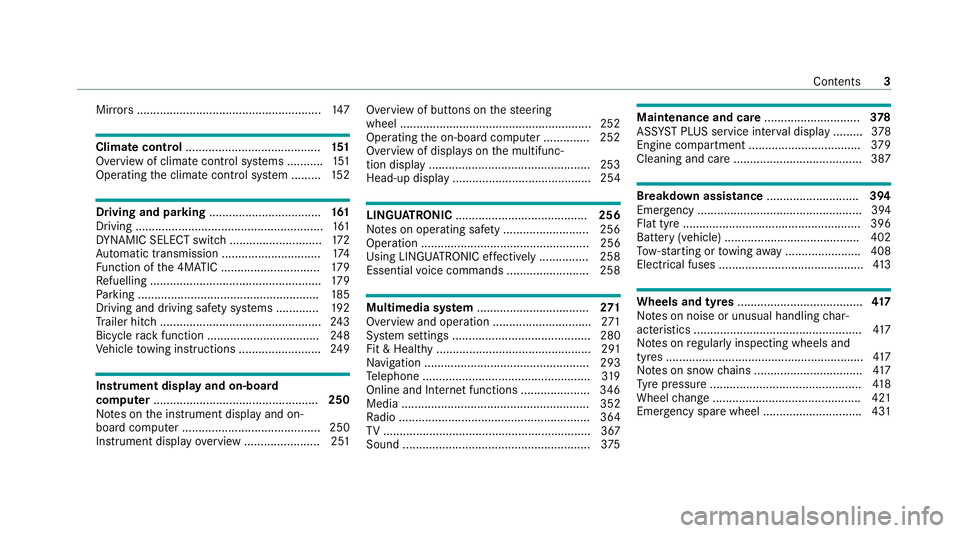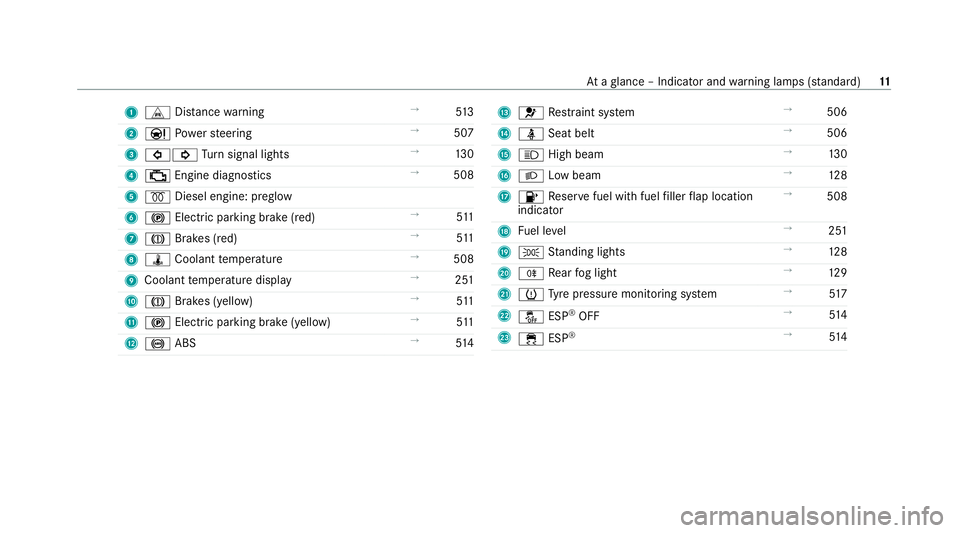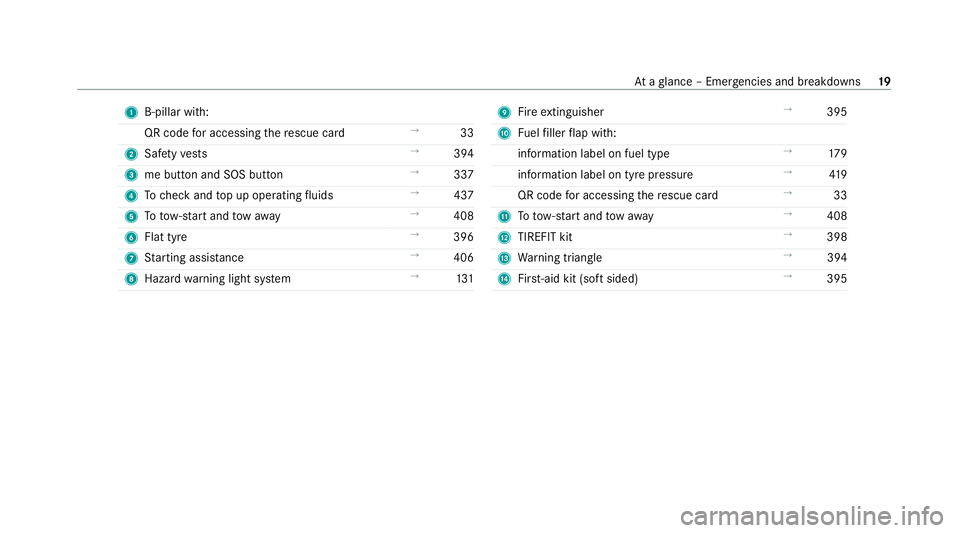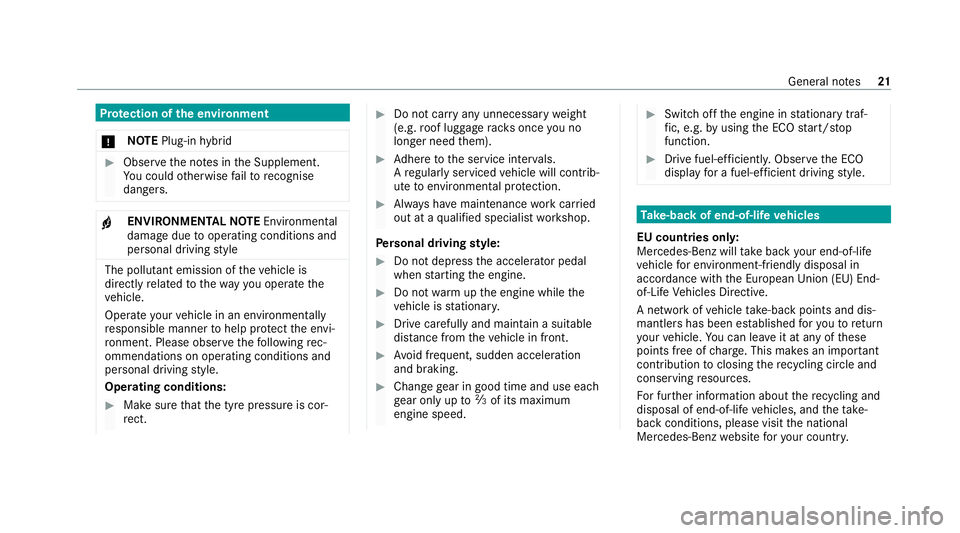2020 MERCEDES-BENZ C-CLASS ESTATE fuel pressure
[x] Cancel search: fuel pressurePage 6 of 565

Mir
rors ........................................................ 147Climate control
......................................... 151
Overview of climate contro l systems ........... 151
Operating the climate control sy stem ......... 15 2 Driving and pa
rking .................................. 161
Driving ......................................................... 161
DY NA MIC SELECT switch ............................1 72
Au tomatic transmission .............................. 174
Fu nction of the 4MATIC .............................. 17 9
Re fuelling .................................................... 17 9
Pa rking ...................................................... .185
Driving and driving saf ety sy stems .............1 92
Tr ailer hit ch................................................. 24 3
Bicycle rack function .................................. 24 8
Ve hicle towing instructions ........................ .249 Instrument display and on-board
comp
uter.................................................. 250
No tes on the instrument display and on-
board computer .......................................... 250
Instrument display overview ...................... .251 Overview of buttons on
thesteering
wheel ..........................................................2 52
Operating the on-board computer .............. 252
Overview of displa yson the multifunc‐
tion display .................................................2 53
Head-up display .......................................... 254 LING
UATRONIC ........................................ 256
No tes on operating saf ety .......................... 256
Ope ration ................................................... 256
Using LINGU ATRO NIC ef fectively ............... 258
Essential voice commands ........................ .258 Multimedia sy
stem .................................. 271
Overview and operation .............................. 271
Sy stem settings .......................................... 280
Fit & Healt hy............................................... 291
Na vigation .................................................. 293
Te lephone .................................................. .319
Online and Internet functions ..................... 346
Media ......................................................... 352
Ra dio .......................................................... 364
TV ............................................................... 367
Sound ......................................................... 375 Maintenance and care
.............................378
ASS YST PLUS service inter val display .........3 78
Engine compartment .................................. 379
Cleaning and care .......................................3 87 Breakdown assistance
............................394
Emergency .................................................. 394
Flat tyre ...................................................... 396
Battery (vehicle) ......................................... 402
To w- starting or towing away ....................... 408
Electrical fuses ............................................ 413 Wheels and tyres
...................................... 417
No tes on noise or unusual handling char‐
acteristics .................................................. .417
No tes on regular lyinspecting wheels and
tyres ............................................................ 417
No tes on snow chains ................................ .417
Ty re pressure .............................................. 41 8
Wheel change ............................................ .421
Emergency spare wheel .............................. 431 Contents
3
Page 14 of 565

1
L Distance warning →
513
2 Ð Powe rst eering →
507
3 #! Turn signal lights →
13 0
4 ; Engine diagnostics →
508
5 % Diesel engine: preglow
6 ! Electric pa rking brake (red) →
511
7 J Brakes (red) →
511
8 ÿ Coolant temp erature →
508
9 Coolant temp erature display →
251
A J Brakes (yellow) →
511
B ! Electric pa rking brake (yellow) →
511
C ! ABS →
514 D
6 Restra int sy stem →
506
E ü Seat belt →
506
F K High beam →
13 0
G L Low beam →
12 8
H 8 Reser vefuel with fuel filler flap location
indicator →
508
I Fuel le vel →
251
J T Standing lights →
12 8
K R Rear fog light →
12 9
L h Tyre pressure monitoring sy stem →
517
M å ESP®
OFF →
514
N ÷ ESP®
→
514 At
aglance – Indicator and warning lamps (s tanda rd) 11
Page 16 of 565

1
#! Turn signal lights →
13 0
2 R Rear fog light →
12 9
3 K High beam →
13 0
L Low beam →
12 8
T Standing lights →
12 8
4 ÿ Coolant temp erature →
508
5 Coolant temp erature display →
251
6 L Distance warning →
513
7 ü Seat belt →
506
8 h Tyre pressure monitoring sy stem →
517
9 Ù Powe rst eering →
507
A ! Electric pa rking brake (yellow) →
511
B ! Electric pa rking brake (red) →
511
C 6 Restra int sy stem →
506 D
ï Trailer hit ch →
507
E J Brakes (red) →
511
F 8 Reser vefuel with fuel filler flap location
indicator →
508
G Fuel le vel →
251
H ä Suspension →
513
I J Brakes (yellow) →
511
J # Electrical fault →
508
K ; Engine diagnostics →
508
L % Diesel engine: preglow
M ! ABS →
514
N å ESP®
OFF →
514
÷ ESP®
→
514 At
aglance – Indicator and warning lamps (widesc reen cockpit) 13
Page 22 of 565

1
B-pillar with:
QR code for accessing there scue card →
33
2 Safetyve sts →
394
3 me button and SOS button →
337
4 Tocheck and top up operating fluids →
437
5 Totow- start and tow aw ay →
408
6 Flat tyre →
396
7 Starting assis tance →
406
8 Haza rdwa rning light sy stem →
131 9
Fire extinguisher →
395
A Fuelfiller flap with:
information label on fuel type →
17 9
information label on tyre pressure →
419
QR code for accessing there scue card →
33
B Totow- start and tow aw ay →
408
C TIREFIT kit →
398
D Warning triangle →
394
E First-aid kit (so ftsided) →
395 At
aglance – Emer gencies and breakdowns 19
Page 24 of 565

Pr
otection of the environment
* NO
TEPlug-in hybrid #
Obser vethe no tes in the Supplement.
Yo u could otherwise failto recognise
dangers. +
ENVI
RONMENTAL NOTEEnvironmental
dama gedue tooperating conditions and
personal driving style The pollutant emission of
theve hicle is
directly related tothewa yyo u operate the
ve hicle.
Operate your vehicle in an environmentally
re sponsible manner tohelp pr otect the envi‐
ro nment. Please obser vethefo llowing rec‐
ommendations on ope rating conditions and
pe rsonal driving style.
Operating conditions: #
Make sure that the tyre pressure is cor‐
re ct. #
Do not car ryany unnecessary weight
(e.g. roof luggage rack s once you no
lon ger need them). #
Adhere tothe service inter vals.
A regularly serviced vehicle will contri b‐
ute toenvironmen tal pr otection. #
Alw ays ha vemaintenance workcar ried
out at a qualified specialist workshop.
Pe rsonal driving style: #
Do not depress the accelera tor pedal
when starting the engine. #
Do not warm upthe engine while the
ve hicle is stationar y. #
Drive carefully and maintain a suitable
dist ance from theve hicle in front. #
Avoid frequent, sudden acceleration
and braking. #
Change gear in good time and use each
ge ar on lyup toÔ of its maximum
engine speed. #
Switch off the engine in stationary traf‐
fi c, e.g. byusing the ECO start/ stop
function. #
Drive fuel-ef ficiently. Obser vethe ECO
display for a fuel-ef ficient driving style. Ta
ke -back of end-of-life vehicles
EU countries onl y:
Mercedes-Benz will take back your end-of-life
ve hicle for environment-friendly disposal in
accordance with the European Union(EU) End-
of-Life Vehicles Directive.
A network of vehicle take -ba ckpoints and dis‐
mantlers has been es tablished foryo uto return
yo ur vehicle. You can lea veit at any of these
points free of charge . This makes an impor tant
contribution toclosing there cycling circle and
conse rving resources.
Fo r fur ther information about there cycling and
disposal of end-of-life vehicles, and theta ke-
back conditions, please visit the national
Mercedes-Benz website foryo ur count ry. Gene
ral no tes 21
Page 167 of 565

Ensu
rethefo llowing before starting the engine:
R the legal stipulations in the area where your
ve hicle is par ked allow engine starting via
smartphone.
R it is safe tostart and runth e engine where
yo ur vehicle is par ked.
R The fuel tank is su fficiently full.
St arting theve hicle (Remo teOnline) &
WARNING Risk of crushing or entrap‐
ment due tounin tentional starting of the
engine
Limbs could be crushed or trapped if the
engine is star ted unintentionally during
service or maintenance work. #
Alw ays secure the engine against unin‐
te ntional starting before car rying out
maintenance or repair work. Re
quirements:
R park position jis selected.
R the anti- theft alarm sy stem is not activated.
R the panic alarm is not activated. R
the hazard warning light sy stem is switched
off.
R the bonn etis closed.
R the doors are closed and loc ked.
R the windo wsand sliding sun roof are closed. #
Start theve hicle using the smartphone.
Af tereve ryengine start, the engine runs for
te n minu tes.
Yo u can car ryout a maximum of two consecu‐
tive starting attem pts. Yo u must start theve hicle
once with theke y before trying tostart the
engine again with the smartphone. you can stop
th eve hicle again at any time.
% Further information can be found in the
smartphone app.
Securing the engine against starting before
car rying out maintenance or repair work: #
switch on the hazard warning light sy stem.
or #
unlock the doors.
or #
open a side window or the sliding sunroof. Ru
nning-in no tes To
preser vethe engine during thefirs t15 00 km:
R drive at varying road speeds and engine
speeds.
R do not drive at speeds greater than
14 0 km/h.
R drive theve hicle in drive program A
or ;.
R shift tothe next highest gear at theve ry lat‐
est when the needle reaches the last third
before there d area in there v counter.
R do not shift down a gear manually in order to
brake.
R avoidove rstraining theve hicle, e.g. driving at
full thro ttle.
R do not depress the accelera tor pedal past
th e pressure point (kickdown).
R only increase the engine speed gradually and
accelera tetheve hicle tofull speed af ter
15 00 km. 16 4
Driving and pa rking
Page 181 of 565

#
Ifth ege arshift recommendation 1appea rs
next tothe transmission position displa y,
shift tothere commended gear. Using kickd
own #
Maximum acceleration: depressthe accel‐
erator pedal be yond the pressure point.
To protect against engine overrev ,th e automatic
transmission shifts up tothe next gear when
maximum engine speed has been reached. Glide mode function
*
NO
TEMercedes-AMG vehicles #
Obser vethe no tes in the Supplement.
Yo u could otherwise failto recognise
dangers. *
NO
TEPlug-in hybrid #
Obser vethe no tes in the Supplement.
Yo u could otherwise failto recognise
dangers. Wi
th an anticipatory driving style, Glide mode
helps youto reduce fuel consum ption.
Glide mode is characterised bythefo llowing:
R The combustion engine is disconnected from
the driv etra in and continues torun in neutral.
R The transmission position displ ayh is
shown in green.
R Vehicles with 48 V on-board electrical
sy stem (EQ-Boost technology): The com‐
bustion engine can be switched off. All of the
ve hicle functions remain active. Glide mode is activated if
thefo llowing condi‐
tions are me t:
R Drive prog ram ; is selected.
R The speed is within a suitable range.
R The road's course is suitable, e.g. no steep
uphill or downhill inclines or tight bends.
R There is no trailer hitched up tothe trailer
hitch, and no bicycle rack Fitted.
R You do not depress the accelera tor or brake
pedal (e xcept for light brake applications).
% Glide mode can also be activated if you ha ve
selected the "Eco" setting forth e drive in the
drive prog ram =.
Glide mode is deactivated again if one of the
conditions is no longer met.
Glide mode can also be pr evented bythefo llow‐
ing parame ters:
R Incline
R Downhill gradient
R Temp erature
R Height 17 8
Driving and pa rking
Page 185 of 565

1
Fuelfiller flap
2 Brac ketfo r fuel filler cap
3 Tyre pressure table
4 QR code forre scue card
5 Fuel type #
Press the back area of fuel filler flap 1. #
Turn the fuel filler cap anti-clockwise and
re mo veit. #
Insert the fuel filler cap from abo veinto
brac ket2. #
Comp lete ly inse rtthe pump nozzle into the
ta nk filler nec k,hook in place and refuel. #
Only fill th e fuel tank until the pump nozzle
switches off.
% Vehicles with a diesel engine: theta nk
fi ller neck is designed forre fuelling at diesel
fi lling pumps.
% Vehicles with a diesel engine: whenthe
fuel tank is compl etely em pty, top up with at
least 5 litres of diesel.
% Vehicles with a diesel engine: use afiller
neck with a lar gediame terfo rve hicles with
a diesel engine when topping up fuel from a
fuel can. Otherwise, thefiller neck cannot
slide into theta nk. #
Replace the cap on thefiller neck and turn
clockwise until it engages audibl y. #
Close fuel filler flap 1. Ad
Blue ®
(vehicles with a diesel engine only) Note
s onrefilling AdBlue ®
Ad Blue ®
is a wate r-soluble fluid forth e NOx
ex haust gas af tertre atment of diesel engines. In
order forth eex haust gas af tertre atment tofunc‐
tion proper ly, only use AdBlue ®
in acco rdance
with ISO 22 241.
Ad Blue ®
is ch aracterised bythefo llowing:
R non-t oxic
R colourless and odourless
R non-flammable
If yo u open theAd Blue ®
tank, small amounts of
ammonia vapour may be released. Only fill the
Ad Blue ®
tank in well-ventilated areas.
Do not let AdBlue ®
come into contact wi thskin,
ey es or clo thes. Keep AdBlue ®
aw ay from chil‐
dren.
Do not ingest AdBlue ®
. If AdBlue ®
is swallo wed,
immediately rinse your mouth out thoroughly.
Drink plenty of water.Seek medical attention at
once. 18 2
Driving and pa rking